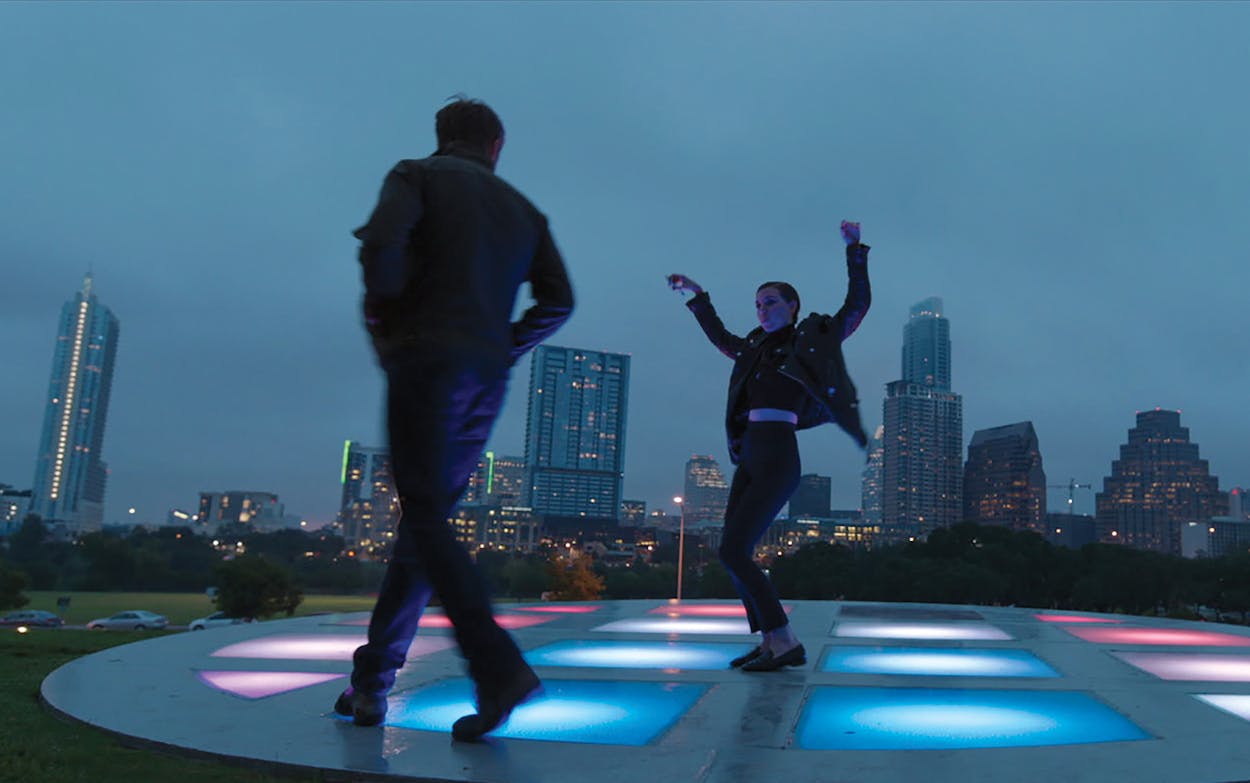Here are a few things you’ll learn from Terrence Malick’s Song to Song, the long-simmering film he began shooting very publicly in Austin in 2011, about artists working in Austin’s music scene:
- How aesthetically pleasing Austin is when captured through the right lens
- What Rooney Mara’s stomach looks like in a variety of settings
- How much fun Ryan Gosling and Michael Fassbender have on the beach
Here are some things you won’t learn:
- Any of the characters’ names
- What any of the characters actually do
- What kind of music any of the musician characters play
- How they afford their obscenely extravagant lifestyles of high-rise condos, Hill Country mansions, and quirky central Austin bungalows
- Anything about the music industry at all
And, as the movie was designed, there wasn’t a lot of room to answer those questions. Song to Song is more or less a random collage of imagery and sounds—sometimes those things are tied together, and sometimes they’re deliberately not. Characters talk to each other while their mouths aren’t moving, people we were led to believe were no longer speaking to one another are happily smiling together, characters we’ve never met before suddenly take on significant importance before disappearing from the film forever. It’s barely a movie in the sense that it doesn’t connect one scene to the other or really tell a story about characters we come to know and understand.
If that style of filmmaking doesn’t do it for you, Song to Song won’t change your mind. It’s passionately uninterested in meeting anyone halfway, instead maintaining a laser-focus on exploring a few very specific things: mostly, what the perceived life of a rock star might be like if it were real, and how it might bum a person out to live that way.
Song to Song stars Ryan Gosling, Rooney Mara, Michael Fassbender, and Natalie Portman. Gosling and Mara play musicians who get entangled in the world of a producer, played by Fassbender. Meanwhile, Portman plays a waitress with whom Fassbender’s character becomes obsessed. We learn these things through one of two means: Either via osmosis, where we see enough random imagery and sparsely-dialoged scenes with these people that we get a sense of what they do, or because Rooney Mara said so in a voiceover.
Gosling and Mara fall in love, but Fassbender—who seems to desire only power and control—keeps a psychosexual hold on Mara for much of the film, promising to sign her to a record label (or whatever exactly it is he does, again, it’s not clear). In a conventional film, this relationship between power, desire, fame, sex, and love would be explored for its dramatic potential—but we’ve already seen Wayne’s World.
Because the the film is almost entirely non-narrative, all of what happens occurs almost without judgment. When new characters appear to further complicate the love triangle—such as Cate Blanchett, Bérénice Marlohe—Song to Song just treats all of them as inevitable, like it’s the natural state of a music scene for everybody to rush out to constantly bone every single newcomers (Fact check: mostly true).
If those sexual appetites of the Austin music industry are an accurate representation of the Live Music Capital of the World, though, it’s probably the only one in the film. There’s documentary-style footage of Austin’s two big fall music festivals, Fun Fun Fun Fest and Austin City Limits, throughout the film, sometimes there for its own sake and sometimes to ostensibly show how important Fassbender’s character is (if he’s palling around with the Red Hot Chili Peppers, he must be important, right?). But beyond that, it’s just a collection of people with an abundance of idle time meandering through life in a series of absurdly opulent settings. The houses all seem to have infinity pools, and the parties are prone to serving sushi off of the naked bodies of beautiful women. Even the characters who are supposed to be broke and jealous of Fassbender’s wealth live in high rise condos that overlook downtown Austin. Anybody who’s spent any real amount of time in the Austin music scene will recognize that as pure fantasy—nobody in the dying music industry of 2017 has the money for naked sushi parties at luxury estates, unless they’re sponsored by American Express or Samsung. But at some point, it becomes clear that Malick wasn’t interested at all in making a movie about the actual music industry, or the actual Austin, or actual musicians.
And that’s the interesting part of Song to Song: it doesn’t reflect the real world in any way worth talking about, but it does reflect a very seductive fantasy about the world of rock and roll. Despite the fact that Song to Song spent five years entrenched in the Austin music world, the audience for the film is bigger than just musicians looking for their own experiences related back to them. The myths of the music world that still compel young people to pick up guitars in the hope that maybe they can “make it,” whatever that even means anymore, are what Malick’s characters are buried in: this is a movie about that perceived world of music, wealth, fame, power, sex, youth, and beauty. Living with four roommates, driving for rideshare companies to make rent, and playing crappy bar gigs to nobody isn’t beautiful in the way that Malick is interested in exploring beauty, so that all gets left out.








